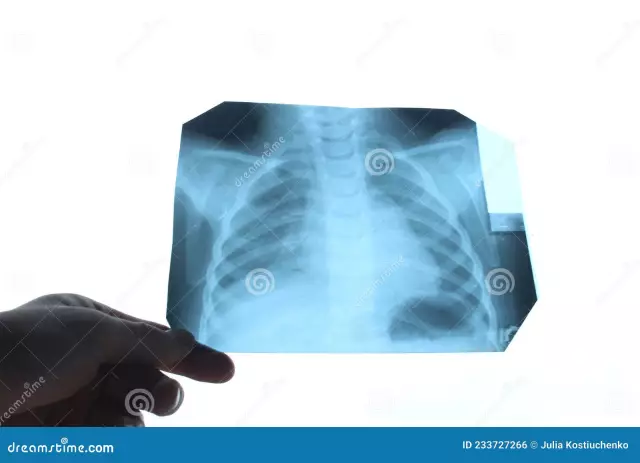- Author Rachel Wainwright [email protected].
- Public 2023-12-15 07:39.
- Last modified 2025-11-02 20:14.
Hypoplasia
The content of the article:
- Kinds
- Causes
- Symptoms
- Hypoplasia treatment
- Potential consequences and complications
- Forecast
- Prevention
Hypoplasia is one of the congenital malformations characterized by the underdevelopment of an organ or its part, which is manifested by a decrease in its size and a decrease in functions. The most severe manifestation of hypoplasia is aplasia, that is, the complete absence of an organ.
The diagnosis of hypoplasia is not made in cases where the child was born with properly formed and developed organs, which later stopped or slowed down their development and growth under the influence of any reason.
Signs of hypoplasia, despite the congenital nature of the pathology, do not always appear from the moment the child is born. For example, hypoplasia of the genitals and mammary glands becomes noticeable only during puberty, when the active growth and development of these organs begins.
Kinds
Hypoplasia can affect both individual organs and the body as a whole. In this case, the pathology is called microsomia or nanism and is one of the forms of dwarfism.
However, most often the pathological process affects individual organs:
- hypoplasia of the teeth;
- hypoplasia of the brain (microcephaly), which is often combined with underdevelopment or abnormalities of the structure and spinal cord;
- hypoplasia of the thyroid gland;
- hypoplasia of the lungs;
- hypoplasia of the kidneys (if only one kidney is underdeveloped, then the second increases in size and takes over the functions of the affected one);
- hypoplasia of the external and internal genital organs (infantilism);
- hypoplasia of the heart;
- hypoplasia of the uterus;
- hypoplasia of the vertebral arteries;
- bone hypoplasia;
- ear hypoplasia (microtia).
Causes
The development of hypoplasia is based on complex disorders of the process of organogenesis, i.e., the formation of organs at the stage of embryonic development. Such violations can lead to:
- genetic abnormalities;
- intrauterine infections (cytomegalovirus, herpes, rubella, syphilis, toxoplasmosis, influenza);
- lack of water;
- smoking, drinking alcohol or drugs;
- exposure to ionizing radiation or occupational hazards;
- living in a region with an unfavorable ecological situation.
Symptoms
The clinical picture of hypoplasia is determined by which organ is affected by the pathological process, as well as the degree of its underdevelopment.
The hypoplasia of one kidney may not manifest itself for a long time, since its function is taken over by the second kidney. Therefore, the disease is often diagnosed by chance, when performing an ultrasound of the abdominal cavity for another reason.

Source: mirnasos.ru
The characteristic signs of tooth enamel hypoplasia are grooves, depressions, whitish spots on the surface of the dental crown. In severe cases, the enamel layer may be completely absent on the affected teeth.

Source: simptomer.ru
Skin hypoplasia is characterized by the appearance of areas of hyperpigmentation with clearly defined boundaries. This pathology is often combined with hypoplasia of other organs, for example, heart, bones, eyes, larynx.
Hypoplasia of the testes in men and ovaries in women is accompanied by a decrease in the level of sex hormones in the body, as a result of which the formation of secondary sexual characteristics is impaired, and libido decreases. The process of maturation of germ cells is disrupted, which leads to infertility.
Uterine hypoplasia can cause recurrent miscarriage. However, with a slight lag in the size of the organ, pregnancy can end happily. The prognosis in terms of maintaining pregnancy with cervical hypoplasia is significantly worse. In most cases, this condition is complicated by the development of isthmic-cervical insufficiency and spontaneous abortion.

Source: medscape.com
The clinical manifestations of lung hypoplasia are determined by the extent of the lesion. If the pathology affects no more than 1-2 segments, then it is asymptomatic. With larger lesions, the child experiences the following symptoms:
- dyspnea;
- cyanosis;
- lag in physical development;
- deformation of the chest;
- hemoptysis;
- chest pain;
- a symptom of drumsticks (thickened nail phalanges of the fingers);
- subfebrile temperature;
- cough.

Source: 900igr.net
Signs of vertebral artery hypoplasia are:
- frequent headaches;
- dizziness, persistent or paroxysmal;
- recurring sensation of incorrect body position in space;
- transient sensory disturbances in different areas of the body;
- increased blood pressure.

Source: tvoelechenie.ru
Hypoplasia treatment
Treatment of hypoplasia is symptomatic, that is, it is aimed at eliminating the clinical signs of the existing pathology, since it is usually not possible to completely eliminate the pathology.
In case of enamel hypoplasia, damaged teeth are covered with crowns, this helps prevent their further destruction. If the area of underdeveloped enamel has a small surface, then it is bleached, and then remineralization is performed.
Hypoplasia of the left heart requires surgical correction, which is carried out in several stages. The first operation is performed in the first hours of a child's life. During it, the opening in the interatrial septum is expanded and, using a special biological prosthesis, the aorta and pulmonary artery are connected to each other, converting them into a single vessel. This improves oxygenation of the body and reduces hypoxia. This operation is technically difficult and is accompanied by a high mortality rate (up to 40%). After the child reaches 6-10 months, the second stage of surgical treatment of hypoplasia of the left heart is performed. It consists in the partial separation of the large and small circles of blood circulation. The complete separation of the pulmonary and systemic circulation is carried out when the child reaches two years of age.
Renal hypoplasia does not require treatment, provided that the second takes over the lost functions of the first. If pyelonephritis of the affected kidney develops or the patient develops arterial hypertension of renal genesis, then there are indications for nephrectomy.
Treatment of cerebral hypoplasia is aimed at reducing the severity of neurological symptoms.
Potential consequences and complications
The consequences of hypoplasia are determined by which organ is affected and the degree of its underdevelopment.
If a child with cerebral hypoplasia survives, he develops one or another degree of mental deficiency, neurological deficit.
Lung hypoplasia is accompanied by frequent inflammatory processes.
A complication of hypoplasia of the genital organs can be infertility, habitual miscarriage, and decreased sex drive.
Forecast
The most severe prognosis is observed with hypoplasia of the lungs and brain. These conditions lead to the disability of patients, and often to death. The most favorable prognosis for dental hypoplasia.
Prevention
Specific measures for the prevention of hypoplasia have not been developed. To reduce the risk of its occurrence, it is necessary to exclude the influence of negative factors on a pregnant woman (occupational hazards, smoking, alcohol, radiation).
YouTube video related to the article:

Elena Minkina Doctor anesthesiologist-resuscitator About the author
Education: graduated from the Tashkent State Medical Institute, specializing in general medicine in 1991. Repeatedly passed refresher courses.
Work experience: anesthesiologist-resuscitator of the city maternity complex, resuscitator of the hemodialysis department.
The information is generalized and provided for informational purposes only. At the first sign of illness, see your doctor. Self-medication is hazardous to health!






